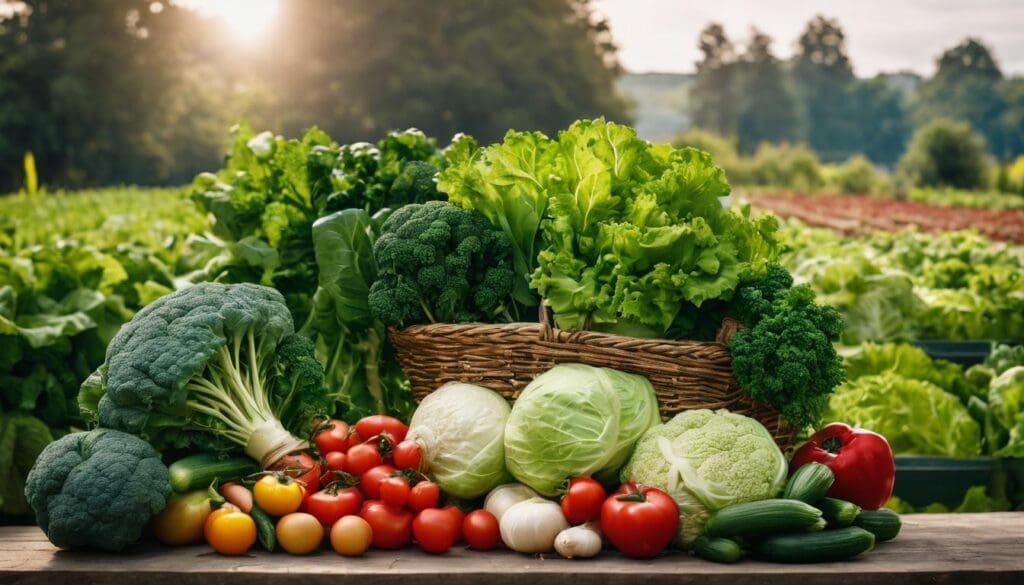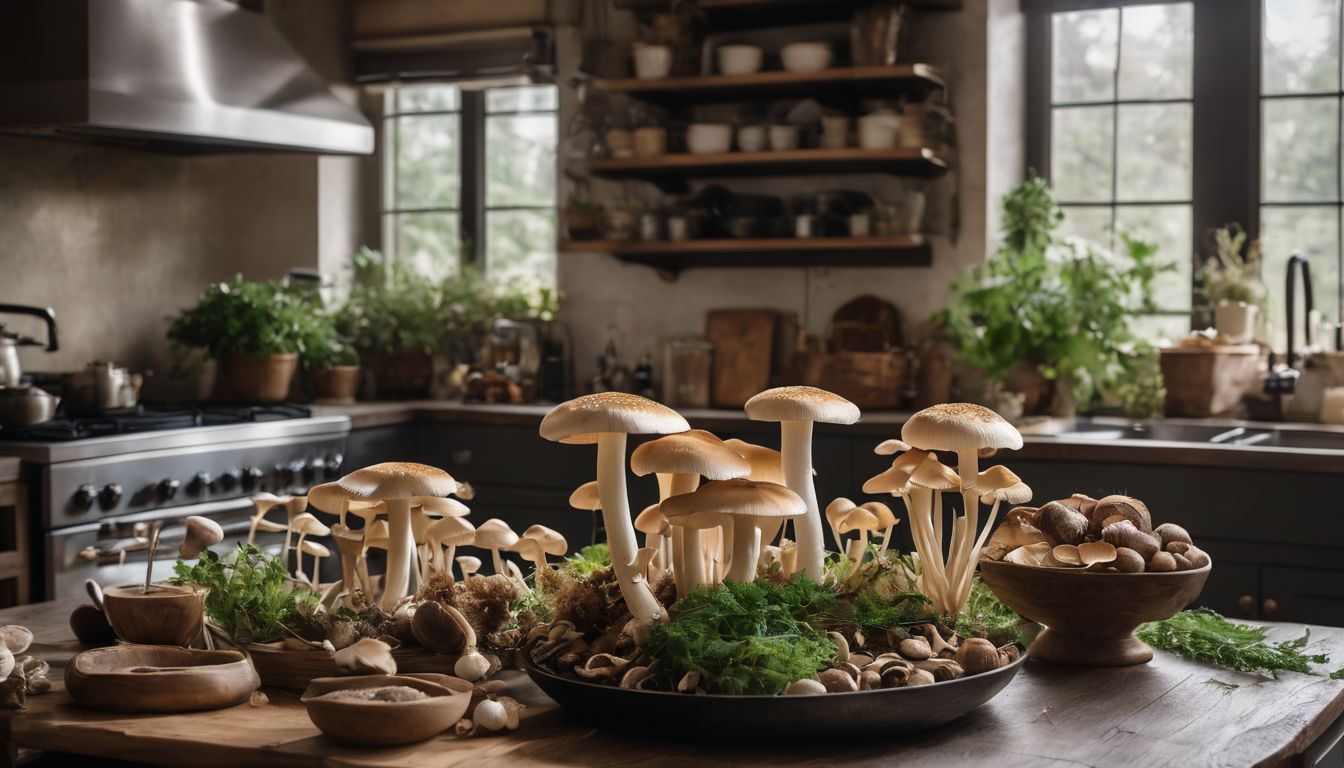Tired of the uncertainty that comes with store-bought veggies? Organic gardening at home ensures you know exactly where your food comes from. This guide will walk you through the steps to cultivate a thriving organic vegetable garden, promising delicious and healthy harvests.
Let’s dig in!
Key Takeaways
- Choose a sunny spot and test your soil to set up the best conditions for organic vegetables.
- Plant a variety of crops and use crop rotation to keep the soil healthy while preventing pests naturally.
- Water carefully and fertilise with organic matter like compost or manure to nourish your plants without chemicals.
- Harvest veggies at their ripest for the freshest taste and store them properly to extend their shelf life.
- Enjoy cooking with homegrown produce, knowing you’re eating healthily and reducing environmental impact.
Benefits of Growing Your Own Organic Vegetables
Growing your own organic vegetables has numerous benefits, including improved health from consuming fresh produce, saving money on grocery bills, and reducing the environmental impact of food transportation and packaging.
Health benefits
Growing your own organic vegetables pumps up your diet with extra nutrients. Fresh harvests mean you’re getting vitamins and minerals at their peak, directly from garden soil to plate without the nutrient loss that occurs in store-bought veggies over time.
Organic produce is free from synthetic chemicals, making them safer for your body and reducing your exposure to pesticides that are commonly found on conventional produce.
Cultivating vegetables at home encourages a more diverse diet because you’re likely to grow varieties not found in your local supermarket. This diversity can lead to a broader intake of essential nutrients.
Plus, tending to an organic garden promotes physical activity, contributing positively to overall health by keeping you active outdoors in the sunlight and fresh air. With these benefits secured, let’s explore how cost savings add another layer of advantage when you choose this sustainable path.
Cost savings
Growing your own organic vegetables can lead to significant cost savings. By eliminating the need to purchase produce from the store, you can reduce your grocery bills and save money in the long run.
Additionally, growing your own vegetables allows you to avoid transportation costs and mark-ups associated with store-bought organic produce. This not only benefits your wallet but also reduces carbon emissions associated with food transportation.
By learning how to grow your own organic vegetables, you can enjoy a continuous supply of fresh, nutritious produce while reducing your environmental impact. The next important step is choosing the right location for your organic vegetable garden, ensuring that sunlight and soil requirements are met.
Environmental benefits
Organic vegetable gardening contributes to environmental sustainability by reducing the reliance on chemical pesticides and fertilisers. As a result, it helps to protect local water sources from pollution and preserves biodiversity in the surrounding ecosystem.
Additionally, organic gardening promotes healthier soil through practices such as composting and mulching, which enhance natural fertility and support long-term agricultural productivity.
Moreover, growing your own organic vegetables reduces the carbon footprint associated with transporting produce from farm to table. By sourcing locally grown food, individuals can minimise fuel consumption and greenhouse gas emissions.
Choosing the Right Location for Your Organic Vegetable Garden
When choosing the right location for your organic vegetable garden, consider sunlight and soil requirements as well as space considerations. These factors will help ensure that your plants have the best chance of thriving.
Sunlight and soil requirements
For successful organic vegetable gardening, a sunny location with at least 6 to 8 hours of sunlight per day is ideal. This ensures that plants receive the energy needed for healthy growth and bountiful harvests.
Additionally, well-draining soil rich in organic matter is crucial for supporting plant roots, providing essential nutrients, and promoting overall plant health. Conducting a soil test can help determine its composition and pH levels, allowing for necessary adjustments to create the optimal conditions for vegetables to thrive.
When selecting a site for an organic garden at home or in urban areas, consider these requirements along with the specific needs of each vegetable variety to ensure success and sustainability.
Space considerations
When starting an organic vegetable garden, space considerations are crucial. You’ll need to choose a location that receives at least six hours of sunlight daily and has well-draining soil.
Additionally, ensure there’s enough room for your chosen vegetables to grow without overcrowding.
For successful vegetable cultivation, raised beds or containers can be used in smaller spaces, optimising the use of available space while promoting proper drainage. Utilising vertical gardening techniques is also beneficial for maximising space and growing more produce in a compact area.
Preparing Your Garden for Organic Growing
Before you start growing your organic vegetables, it’s important to prepare your garden properly. This involves testing the soil, making necessary adjustments, composting and choosing organic seeds and transplants.
Testing soil and making necessary adjustments
Before planting your organic vegetables, it’s crucial to test the soil. Determine the pH level and nutrient content to identify any deficiencies. Based on the results, make necessary adjustments by adding organic fertilisers or compost to enrich the soil.
This ensures that your plants have the right conditions for healthy growth, promoting a bountiful harvest of nutritious produce.
To create an optimal environment for your organic vegetable garden, focus on maintaining balanced soil health throughout the growing season. Regular testing and adjustments will help you cultivate thriving plants without relying on synthetic chemicals or additives, aligning with eco-friendly farming practices.
Composting
To enrich your organic vegetable garden, start composting. Utilise kitchen scraps and yard waste to create nutrient-rich soil for your plants. Begin by layering green and brown materials in a compost bin or pile.
Stir the mixture regularly to promote decomposition. In a matter of months, you’ll have homemade compost ready for use in your garden.
By implementing this simple and eco-friendly practice, you reduce waste while providing natural nourishment for your homegrown produce. Composting aligns with the ethos of environmentally conscious individuals who support conservation and sustainable living practices.
Choosing organic seeds and transplants
To start your organic vegetable garden, it is crucial to select high-quality organic seeds and transplants. When choosing seeds, look for varieties that are well-suited to your local climate and growing conditions.
Be sure to read the labels or packaging to ensure they are certified organic and free from genetically modified organisms (GMOs). Acquire transplants from reputable nurseries or farmers’ markets, ensuring they have been grown without synthetic pesticides or fertilisers.
Avoid using conventional seeds or transplants as these may contain harmful chemicals that contradict the principles of organic gardening.
When selecting seeds and transplants, consider native species that are adapted to your area as they tend to require less maintenance. Additionally, choose disease-resistant varieties whenever possible to reduce the need for chemical interventions later on in the growing process.
Growing and Maintaining Your Organic Vegetable Garden
Proper watering and fertilisation, along with pest management and prevention, are essential for the health of your organic garden – learn how to keep your plants thriving. Read more about these important steps in our blog post on growing your own organic vegetables.
Proper watering and fertilisation
For healthy organic vegetables, water the garden regularly to keep the soil moist. Use a soaker hose or watering can to avoid wetting the leaves and causing disease. Apply organic fertilisers such as compost or manure to nourish the plants naturally.
These methods promote strong growth without harmful chemicals, supporting ecofriendly farming practices while yielding nutrient-rich produce for your home.
Maintain optimal soil moisture by watering in the morning to allow excess moisture to evaporate during the day, reducing fungal diseases that thrive in damp conditions. Regularly inspect plants for signs of nutrient deficiencies and adjust fertilisation accordingly with natural solutions like fish emulsion or seaweed extract, keeping your urban gardening efforts thriving with minimal environmental impact.
Pest management and prevention
To maintain a healthy organic vegetable garden, implement pest management and prevention techniques. Regularly inspect plants for signs of pests and promptly address any infestations.
Utilise natural remedies such as neem oil or insecticidal soaps to control common pests like aphids and caterpillars. Additionally, encourage beneficial insects such as ladybugs and lacewings to naturally regulate pest populations in your garden.
Implementing physical barriers like row covers can also prevent pests from damaging your crops.
For healthy plant growth, focus on building soil health through composting and mulching to promote strong plant immunity against disease and pests. Rotate crops annually to minimise the risk of specific pests taking hold in the soil.
Crop rotation
Rotate your crops annually to maintain soil health and reduce the risk of disease. This method involves planting different types of vegetables in a specific order each season, preventing nutrient depletion and deterring pests.
By diversifying what you grow in each area of your garden, you can improve overall soil quality and boost crop yields. Consider alternating between legumes, root vegetables, leafy greens, and fruits to utilise available nutrients effectively while reducing the need for chemical fertilisers.
Regularly rotating crops also helps break pest life cycles and lessen weed pressure by disrupting their habitual environment. This sustainable practice promotes biodiversity within your garden, making it more resistant to potential threats.
Harvesting and Enjoying Your Organic Vegetables
Once your organic vegetables are ready to harvest, be sure to do so at the peak of freshness for maximum flavour and nutrition. With a variety of recipes and meal ideas, you can enjoy the fruits of your labour while reaping the benefits of your own organic produce.
Tips for harvesting and storing
To ensure your organic vegetables are at their freshest and most flavourful, here are some essential tips for harvesting and storing:
- Harvest fully ripe vegetables in the early morning when they’re crisp and full of moisture.
- Handle your vegetables with care to avoid bruising or damaging the produce during harvesting.
- Clean your harvested vegetables promptly to remove any soil, debris, or insects before storage.
- Choose appropriate storage containers such as breathable mesh bags, wooden crates, or paper bags for different types of vegetables.
- Store root vegetables like carrots, beets, and potatoes in a cool, dark place to maintain freshness and prevent sprouting.
- Keep leafy greens like lettuce and kale refrigerated in airtight containers or plastic bags with a paper towel to absorb excess moisture.
- Avoid washing vegetables before storing them unless absolutely necessary to prevent premature spoilage.
- Label and date your stored vegetables to keep track of their freshness and use them before their peak period is over.
- Regularly check on your stored produce to remove any spoiling items that may affect the rest of the batch.
- Utilise your freshly harvested organic vegetables in delicious recipes or share them with friends and family to enjoy the bounties of your own garden while promoting sustainable living.
Recipes and meal ideas
After harvesting and storing your organic vegetables, it’s time to bring them to the table in delicious meals. Try roasting a mix of organic root vegetables with olive oil, sea salt, and fresh herbs for a simple and savoury side dish.
Another idea is to toss freshly-picked salad greens with a homemade vinaigrette using organic olive oil, balsamic vinegar, Dijon mustard, and honey for a refreshing starter. For main courses, consider making vegetable stir-fries or pasta primavera using an assortment of organically grown produce from your garden.
These recipes not only highlight the natural flavours of your vegetables but also support sustainable eating practices.
Reaping the benefits of your own organic produce
Growing your own organic produce comes with an array of benefits. First, you can enjoy the satisfaction of knowing exactly where your food comes from and how it was grown, promoting health and well-being for you and your family.
Additionally, by skipping out on store-bought produce, you’re reducing environmental impact through fewer emissions related to transportation. Sticking to organic gardening methods means no harmful chemicals are involved in the process too.
When reaping the benefits of your own organic produce, there’s also a sense of convenience – picking fresh vegetables just when they’re ripe ensures maximum flavour and nutritional value.
Moreover, cultivating your garden is a great way to save money on groceries while ensuring that what ends up on your plate is natural and chemical-free!
Conclusion
In conclusion, cultivating your own organic vegetables brings numerous benefits. You’ll enjoy the satisfaction of eating fresh, chemical-free produce while reducing your environmental impact.
By following these steps and putting in a little effort, you can create your own sustainable garden filled with delicious and nutritious vegetables. Now is the time to start your journey towards greener living and delicious homegrown meals!
FAQs
1. How do I start an organic garden at home?
To start a vegetable garden organically, choose a sunny spot, prepare your soil without chemicals, and select local varieties of vegetables to grow.
2. What are some tips for growing organic vegetables for beginners?
Beginners should start small with their DIY vegetable growing project by learning organic gardening techniques like composting and natural pest control.
3. Can I grow vegetables organically without using any chemicals?
Yes, you can practice chemical-free gardening by using natural methods such as companion planting and handmade fertilisers made from kitchen waste.
4. Where can I find resources to help me with starting my own organic garden?
You’ll find many organic gardening resources online or in books that offer guidance on everything from soil health to harvesting your locally sourced produce.
5. Is it cost-effective to grow my own organic vegetables at home?
Growing your own veggies can save money in the long run because you’re producing fresh, healthy food right from your garden instead of buying it from the store.





